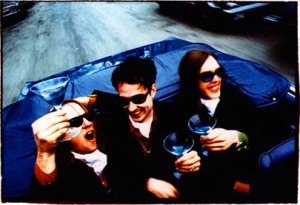Riffs, Rants & Rumors: Camera King Danny Clinch's Journey of Discovery
posted in: Exclusive Interviews • Features • Rock
 Pearl Jam. Bruce Springsteen. Neil Young. Radiohead. Green Day. Practically every rock icon who has seen the light of day in the last couple of decades has been on the business end of Danny Clinch‘s camera. Not only has Clinch emerged as his generation’s preeminent rock & roll photographer, he’s also directed videos for everyone from Tom Waits to the Foo Fighters, and his 1999 photo book, Discovery Inn, stands as one of the modern era’s finest collections of music photography. Now Discovery Inn has been updated for the iPad age, as an interactive app that includes not only the unforgettable images from the original book, but an abundance of additional multi-media material.
Pearl Jam. Bruce Springsteen. Neil Young. Radiohead. Green Day. Practically every rock icon who has seen the light of day in the last couple of decades has been on the business end of Danny Clinch‘s camera. Not only has Clinch emerged as his generation’s preeminent rock & roll photographer, he’s also directed videos for everyone from Tom Waits to the Foo Fighters, and his 1999 photo book, Discovery Inn, stands as one of the modern era’s finest collections of music photography. Now Discovery Inn has been updated for the iPad age, as an interactive app that includes not only the unforgettable images from the original book, but an abundance of additional multi-media material.
 Clinch comes by his claim to the Annie Leibovitz mantle honestly, as he learned directly from her, having worked as an intern for her at the beginning of his career. “Her work ethic was amazing,” Clinch recalls, “She never took no for an answer. However she wanted to get things done she would get them done, she was just really driven.” Perhaps even more importantly, Clinch learned from her how to put his subjects at their ease. “She just has a way with people and getting them comfortable that not too many people have,” says Clinch, touching on a skill that is one of his own not-so-secret weapons.
Clinch comes by his claim to the Annie Leibovitz mantle honestly, as he learned directly from her, having worked as an intern for her at the beginning of his career. “Her work ethic was amazing,” Clinch recalls, “She never took no for an answer. However she wanted to get things done she would get them done, she was just really driven.” Perhaps even more importantly, Clinch learned from her how to put his subjects at their ease. “She just has a way with people and getting them comfortable that not too many people have,” says Clinch, touching on a skill that is one of his own not-so-secret weapons.
The priority on Clinch’s own agenda is always remaining respectful of the moment while illuminating the essential aspects of whoever is standing in front of his lens. “I’m trying to capture something about the person that’s gonna resonate with the viewer,” explains Clinch, “I’m not overly directing them.” That naturalistic quality is ever present in Discovery Inn, a collection Clinch says first came to life as an idea through “these friends of mine who had started that company Razorfish. They had done really well for themselves, and they’re big supporters of the arts. They said ‘Let’s do a book of your photographs.’ We had no guidelines, no one was saying ‘Put this on the cover, it’ll sell better.’ We made this book and we wanted to keep it really simple.”
As impactful as the original book was, Clinch eventually realized it could do with an update. “I made that book in ’98,” he relates, “and I hadn’t at that point photographed Bob Dylan or Bruce Springsteen, or developed my relationships with Neil Young, Pearl Jam and all that. It’s kind of a first chapter in my career.” The new app version of Discovery Inn takes advantage of both Clinch’s subsequent experiences and the expansion of technology. “Each photograph has a story that’s just as good if not better than the photo,” he declares. “Even the experience of getting the photo is really important.” The app allows Clinch to share “a little bit more about the whole experience I had doing it, by talking about it. There’s a little bio about [each artist] in there, and where they were at that point in their career. There’s stories that I tell about the artists. There’s a link to iTunes to listen to some of the music. And my good friends from Blind Melon gave me a couple of instrumental tracks to put on there, that you can click on to listen to while you’re thumbing through the app”songs that have never been heard.”
 Reminiscing about some of the most memorable images included in Discovery Inn, Clinch recalls a particularly immersive experience with Chicago alt-rockers Urge Overkill at the peak of the band’s mid-’90s fame. “I was shooting that for Spin,” he recalls. “I went out to Chicago. I couldn’t have been happier than to end up with Urge Overkill, these guys were such characters, having such a great time with themselves and their music, they were really up for anything. They had this old convertible, and I thought, ‘Let’s throw you all in the back and we’ll ride around and drink martinis and put on ascots and have a good old time.’ We were riding around and I remember Blackie [Onassis, drummer] at some point said ‘The car’s blue, our outfits are blue, the interior’s blue¦I’ll be right back!’ He comes back with a martini glass filled with this blue liquid¦he’d put Windex in there! I think he actually sipped it once because he was thinking it was a martini. My assistant and I stayed overnight in the studio where they were recording. Blackie said, ‘Here’s my hangover cure-all”take two Motrin and a multivitamin with a huge glass of water, and when we wake up in the morning, you’ll feel just fine.'”
Reminiscing about some of the most memorable images included in Discovery Inn, Clinch recalls a particularly immersive experience with Chicago alt-rockers Urge Overkill at the peak of the band’s mid-’90s fame. “I was shooting that for Spin,” he recalls. “I went out to Chicago. I couldn’t have been happier than to end up with Urge Overkill, these guys were such characters, having such a great time with themselves and their music, they were really up for anything. They had this old convertible, and I thought, ‘Let’s throw you all in the back and we’ll ride around and drink martinis and put on ascots and have a good old time.’ We were riding around and I remember Blackie [Onassis, drummer] at some point said ‘The car’s blue, our outfits are blue, the interior’s blue¦I’ll be right back!’ He comes back with a martini glass filled with this blue liquid¦he’d put Windex in there! I think he actually sipped it once because he was thinking it was a martini. My assistant and I stayed overnight in the studio where they were recording. Blackie said, ‘Here’s my hangover cure-all”take two Motrin and a multivitamin with a huge glass of water, and when we wake up in the morning, you’ll feel just fine.'”
 Clinch once came within a hair’s breadth of getting a karate kick in the head from Radiohead singer Thom Yorke, a rock star not usually known for his violent physical outbursts. “We were shooting for this magazine Ray Gun,” explains Clinch. “We were shooting on the street in New York City, walking around. I had the guys all leaning on this bench, and I asked Thom to stand on the bench. Then he says ‘What about this?’ and he just leaped off the bench without much warning, and I just backed up and snapped the shot. It was kind of a spontaneous moment that I was thankfully ready for. He most likely would have kicked me [if I hadn’t backed up].”
Clinch once came within a hair’s breadth of getting a karate kick in the head from Radiohead singer Thom Yorke, a rock star not usually known for his violent physical outbursts. “We were shooting for this magazine Ray Gun,” explains Clinch. “We were shooting on the street in New York City, walking around. I had the guys all leaning on this bench, and I asked Thom to stand on the bench. Then he says ‘What about this?’ and he just leaped off the bench without much warning, and I just backed up and snapped the shot. It was kind of a spontaneous moment that I was thankfully ready for. He most likely would have kicked me [if I hadn’t backed up].”
Through his powers of persuasion, Clinch once even managed to convince ornery punks Green Day to squeeze themselves into a single car trunk in the name of art. “That was for the cover of Spin,” he remembers. “I went on a bit of a tour with them, I did some Lollapalooza dates with them and we went down to New Orleans. I saw these old cabs¦red and yellow and some crazy colors. I said ‘I’d like to photograph you in one of these cabs.’ It was bright orange. I thought ‘What else can we do?’ I was like, ‘How about getting you guys all in the trunk?’ So they all climbed in the trunk, and they were spilling out, and legs were hanging out here and there, and we were really having a good time. I said ‘Everybody climb in, and I’m gonna lower this down and have just your faces peeking out,’ and that’s what we did”it ended up being a classic.”
 For all Clinch’s technical skill at his craft, his work is ruled first and foremost by feeling, which is probably why he works so well with musicians powered by their passions. “The musicians that I gravitate towards, especially at this point in my career, tend to be people like that,” he affirms. “The musicians that I really enjoy photographing are the ones that mean something to me personally, the ones who have heart. I see people like Johnny Cash and Neil Young and Bruce Springsteen, and younger bands like My Morning Jacket and The Black Keys as people I just feel are cut from the same cloth, and I kind of gravitate to them.”
For all Clinch’s technical skill at his craft, his work is ruled first and foremost by feeling, which is probably why he works so well with musicians powered by their passions. “The musicians that I gravitate towards, especially at this point in my career, tend to be people like that,” he affirms. “The musicians that I really enjoy photographing are the ones that mean something to me personally, the ones who have heart. I see people like Johnny Cash and Neil Young and Bruce Springsteen, and younger bands like My Morning Jacket and The Black Keys as people I just feel are cut from the same cloth, and I kind of gravitate to them.”
The digitally expanded Discovery Inn is Clinch’s attempt to put the viewer in closer proximity to those feelings, while offering consumers the best possible value. “I’ve seen some other [photography] apps where you buy the app for five dollars, and you get in there and try to blow them up to look at them and they’re all pixelated, and you have to pay an extra couple of dollars to get the hi-res version,” he says. “We made a conscious effort to just make it affordable for people…we tried to make it as accessible as possible. I think it offers people a lot more insight than what the original book did. I think it’s a good opportunity for those that are fans of music and photography to get a little more insight into how the pictures were taken.”
